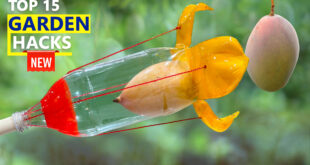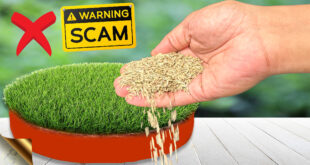In Today’s post, Let’s look into the 10 incredible uses of diluted hydrogen peroxide in gardening plus one powerful lockdown pesticide gardening idea using hydrogen peroxide.
Have you noticed, how plants suddenly look greener during rainy season? One of the reasons is hydrogen peroxide found in small amounts naturally in rain water.
Although Hydrogen Peroxide is a chemical, but it easily decomposes to water and oxygen, and hence safe to be used even in organic gardening in varying dilutions. It is a colourless and odourless liquid and a commonly used medical and household disinfectant.
Now, the Concept for using Hydrogen peroxide in garden: It has a chemical formula H2O2 similar to that of water, but with an extra oxygen atom. This concept of additional oxygen release when hydrogen peroxide breaks down is the key to its beneficial effects in gardening.
Well, before we list out the top 10 benefits of hydro gen peroxide in garden, you must be aware of what concentration to purchase from the medical stores. It’s very inexpensive and commonly available in 3%, 6% and sometimes 35%. We will be using 3% or 6% hydrogen peroxide in our garden. Please watch this video till the end!
10. Save a Dying Plant: Applying the concept of extra oxygen atom release, we can revive a dying plant with hydrogen peroxide. First Check by scratching the stem, if its green and juicy, then it can be revived. Cut off all the dead branches and stem till the viability zone or the green zone. Take out the plant by its roots. Inspect the roots for any rot. Prepare a diluted hydrogen peroxide solution using 3% or 6%. Use 2-3 teaspoons of 3% peroxide per litre or 2 tablespoons per gallon of water. If you are using 6%, the dosage is half of this. Now soak the roots into this solution for about 6 hours. Then repot this in a clean fresh potting mix and new container. Water this with the same solution and leave it alone in shade for few days. Water the plant only when 1 or 2 inches of top soil dries out completely. You can repeat watering with this solution till it begins to show signs of life.
9. Accelerate Seed Germination: Seeds soaked in diluted hydrogen peroxide germinate faster and display healthy growth in future. Since the oxygen requirement of sprouting seeds is very high, this extra oxygen supply is obviously beneficial. You can soak seeds in a solution with 1-2 teaspoons of 3% peroxide per litre of water or water the seedling tray of seeds are already planted. This also takes care of any seed borne pathogens and helps in better root development of the seedlings.
8. Disinfecting Garden tools: especially the cutting and pruning tools should be disinfected while taking plant cuttings for rooting or cloning your plants. You can use 6% h2o2 solution to wipe off the cutting tool with a cotton or dip the tool into the solution for few minutes. This increases the chances of a high success rate in growing plants from cuttings.
7. Disinfect Seed Germination Trays: for a high success rate in germination your seed trays have to be free from pathogenic microorganisms. You can wipe them with 6% solution without any dilution.
6. Treat Fungal or Bacterial Root Rot: Overwatering can cause a shortage of oxygen at the roots. By filling the air pockets found in the soil around your plants, suffocating the roots of the plant. This lack of air causes the plants to start dying due to root rot. To treat this problem, you can water them with a mixture of two to three teaspoons of 3 percent hydrogen peroxide per litre of water or 2 tablespoons per gallon of water. The extra oxygen found in the hydrogen peroxide delivers the much-needed oxygen to the plant’s roots. After applying this solution to your plants avoid watering again until the top two inches of the soil is completely dried.
5. To Sterilize the Seed Starting Mix for better success in seed germinations. Add a 1:3 dilution of 3% h2o2 in water to the seed starting mix and leave it over night before using the soil or mix for seed sowing. You can also sprinkle this on your potting mix to disinfect your potting soil.
4. Weed Killer: At 10% or higher concentration of hydrogen peroxide, it completely destroys all types of vegetation it comes in contact with. But use it with caution around your plants. This is best applicable for cracks and crevices.
3. As a Fertilizer: Water your plants with a very dilute solution of hydrogen peroxide once in a month for the rain effect. You can add 1 teaspoon per litre of 3% hydrogen peroxide or 1 table spoon per gallon of water and water your plants to supply oxygen to the roots.
2. In hydroponic or aquaponics system: the addition of hydrogen peroxide to the water will keep the plants healthy. The roots of plants, as well as the aquatic life, appreciate the extra supply of oxygen.
1. EFFECTIVE PESTICIDE AND ANTI FUNGAL: It can control many common pests and insects in garden, mainly the sap sucking pests like aphids, mites and mealybugs. It can kill the eggs and larvae of moths and other harmful pests with its strong oxidizing effect. To make this pesticide, use 1 cup that’s about 250 ml of 6% hydrogen peroxide per litre of water or 2 cups of 3% h2o2 per litre of water. Load it in a spray bottle and spray on the plants. To control Fungus gnats and soil pests, you can water the plant with the same solution. It can also used in the treatment of mold and powdery mildew fungus.
 GKVKs – Gardening Tips and Store Gardening Tips and Store
GKVKs – Gardening Tips and Store Gardening Tips and Store



